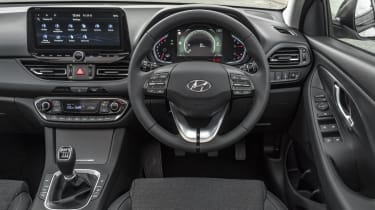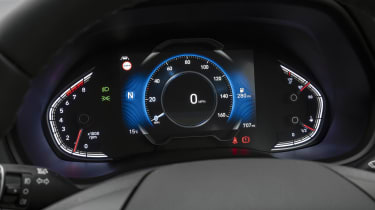Hyundai i30 review - Engines, performance and drive
The 1.0 T-GDi turbo is our pick of the range, whether you’re a private or business buyer

The Hyundai i30 is a capable and well-rounded car, and one that easily competes with the best in class when it comes to long-distance refinement. The SEAT Leon and Ford Focus are more fun, though the entry-level i30 feels sprightly and surprisingly good to drive thanks to the lightweight three-cylinder turbo petrol engine.
What’s important with hatchbacks like this is ride quality. The i30 deals well with rough roads up to a point, beyond which the suspension starts to struggle. In spite of the new model's more sophisticated rear axle, there’s a noticeable level of body movement that can be felt from the cabin. A Volkswagen Golf is better at soaking up bumps, while the ride imperfections are exacerbated on N Line models with their firmer suspension and big wheels.
Apart from this, the i30 is a comfortable cruiser, with enough wheel control to smother most surface imperfections and keep things calm for passengers. The downside is that the Hyundai doesn’t sparkle all that much dynamically. There’s plenty of grip, but you wouldn’t know it through the steering. While Hyundai has dropped its largely ineffective FlexSteer power-assistance system, the wheel still feels lifeless, with a constant weight no matter what speed you’re doing or how much lock you add. The wheel feels inert as a result, although the fairly positive six-speed manual goes some way to rescuing the driving experience.
Used - available now
The entry-level 1.0-litre engine now also comes with the option of a seven-speed automatic gearbox, alongside the standard-fit six-speed manual, just like the more powerful petrol models. The automatic option costs £1,200 across the range, barely affects fuel economy and shifts smoothly under gentle acceleration. Push harder and you’ll wish you opted for the manual, though.
The new i30 N is a wonderful car to drive, so much so that we gave it a full five-star rating on our first drive in Germany. Although not as quick or powerful as a Honda Civic Type R, its terrific chassis and brilliant steering are certainly to be admired. It races to the redline with virtually no turbo lag, with a sweet-shifting six-speed gearbox adding to the thrilling drive. We also love the rev-matching tech, which allows for quick and smooth downshifts without the need to heel-and-toe.
The N model received a few mechanical tweaks in early 2020 that help it perform just a little bit more capably on UK tarmac than the original. However, the firm ride still remains, so we’d still use the excellent customisation feature to fine-tune our own ‘sport’ set-up, mixing the most aggressive power delivery with the most comfortable dampers.
There’s loads of safety kit on the new i30, most of which just works away in the background. Autonomous Emergency Braking and Front Collision Warning are both included alongside Lane Keeping Assist and Driver Attention Alert.
Engines, 0-60 acceleration and top speed
The Hyundai i30 range currently comprises two petrol engine options (three if you include the 2.0-litre in the hot hatch i30 N) – and it’s the entry-level 1.0 T-GDi turbo petrol that offers the best blend of performance and running costs.
The 1.0 is very refined. At idle it’s only possible to detect a faint hum from the three-cylinder engine, although it does get noisier when you pull away. With 118bhp and 172Nm of torque, performance is reasonable, and the i30 matches more powerful and torquier rivals; it can thank a relatively low kerbweight for that. However, in gear performance isn't quite as strong, and the i30 took 12.6 seconds to accelerate between 50 and 70mph in sixth. That's a second slower than a 1.2 TCe-powered Renault Megane, while a 1.0-litre TSI Volkswagen Golf will accelerate quicker and feels a bit less lethargic.
Next up is the more powerful 1.5 T-GDi. Also turbocharged, the bigger capacity unit doesn’t offer as many benefits as it might appear to on paper. Hyundai claims a much quicker 0-62mph sprint of 8.9 seconds, but in reality the difference doesn’t feel all that great. It’s more refined at high speed, though, feeling less stressed at the top end. Mated to the sportier N-Line spec, it looks very much like a cheaper i30N.
The flagship i30 N Performance is powered by a 2.0-litre four-cylinder turbocharged petrol engine, developing 276bhp and 392Nm of torque. Acceleration from standstill to 62mph takes 6.1 seconds, with a top speed of 155mph.














